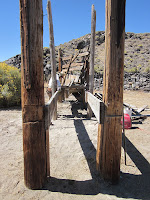Last weekend I had the opportunity to assist the crew of a USGS researcher trapping Greater Sage-Grouse (
Centrocercus urophasianus) in the Virginia Mountains north of Reno, NV. Two nights previously, they saw 80 grouse, but by the night I was there we only saw 6. Slightly disappointing, but at the same time it was exciting to be in the middle of their transition to winter range. A Nevada Department of Wildlife employee is going to be flying the area to find out where the grouse actually spend their winter, one of the things that this study will tell us.
So how do we trap the grouse anyway? Honestly it's one of the more bizarre wildlife-trapping methods I've experienced. We worked in teams of two. I had the relatively simple job of following the team leader through sagebrush by headlamp, carrying a long-handled net. He did everything else. Using binoculars and a spotlight, he scanned the area to try and catch eyeshine from the grouse. As we snuck closer, he would spotlight the bird and turn on a speaker hooked up to a radio tuned to static. The grouse will flush at the sound of footsteps (walk without rythym...), so any loud noise disguises our steps and keeps the poor bird disoriented. My boss says they used to use chainsaw motors, and some people play music, although the regular beat in songs may not be as successful as noise. Many people use three person teams, with two netters behind the spotlighter. We only needed two because we had a pretty slick net gun. The leader shot the net over the bird, then I followed in to put the long-handled net over it to keep it from escaping.
Normally they take a lot of measurements on the bird, but the focus was to get radio collars on as many birds as possible before the winter. We took pictures and some blood, but the rest of the measurements will be taken when the birds are recaptured next year. We were only able to catch one bird that night, but I'm glad I had the opportunity to do so!

























































